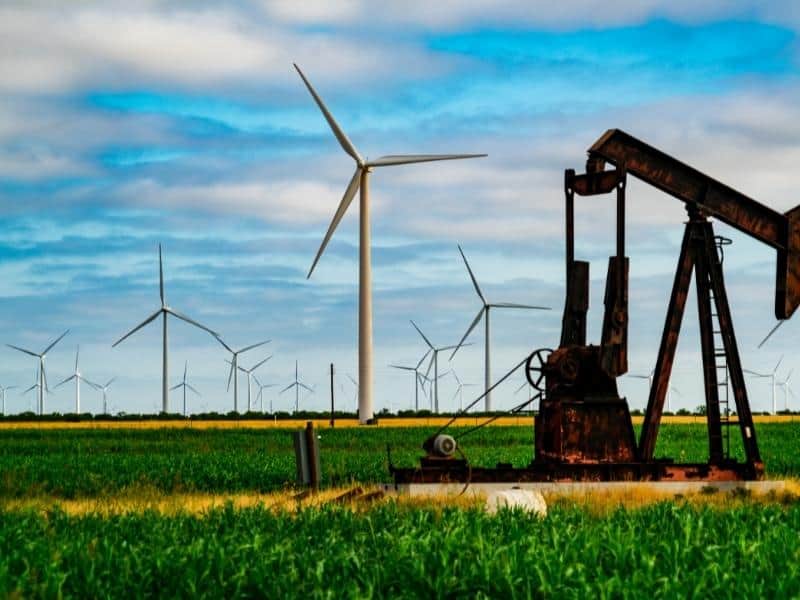Wind turbines are complex machinery pieces with several moving parts and gearboxes, driveshafts, and rotors (amongst others) that all require lubrication of various kinds to remain operationally effective.
Wind turbines use oil and quite a lot of it, and the type of oil can vary depending on the location and load on the gearbox and other moving parts. Like your car, the wind turbine requires regular servicing, primarily where they operate under harsh weather conditions.
We’ll need to look at the following factors:
- How much oil do wind turbines use
- The frequency of oil changes
- Do wind turbines need specialized oils
- Why the quality of the oil is important
- Does the weather affect the oil consumption
Taking a more thorough look into the use of oil in wind turbines, we’ll see how much oil they use, the maintenance implications, and the use of a new technology in turbines that virtually reduces the need for oil.

How Much Oil Does A Wind Turbine Use?
Older wind turbines built in the 1980s had smaller gearboxes than the ones used today, and these would hold about ten gallons of oil that were put into the gearbox. The more modern ones with larger gearboxes can have as much as sixty gallons of oil!
Oil is pumped through the gearbox or uses a gravity-feed system to keep the parts lubricated. While many turbines use synthetic oils for their gearboxes, a growing school of thought suggests that oils should be formulated specifically for wind turbine gearboxes.
How Often Is The Oil In Wind Turbines Changed?
Before developing specialized synthetic oils specially formulated to maintain extended lubrication for gearboxes, intervals could be around 8-12 months between oil changes.
Lubrication is one of the critical elements in operational longevity for wind turbine gearboxes. Due to their often remote location, gearbox oil may only be checked once or twice a year.
The problem with this is two-fold.
Firstly, the maintenance costs are high as these towers can rise to over 300ft, and you would require specialized technicians or ‘windtechs’ to do this.
Secondly, during maintenance, the turbines are not generating power, which leads to the lowered capacity of the grid – and both of these cost the owner money.
So the goal was to develop more efficient oils that would only require changes every three years, and they would be able to survive and withstand the operating conditions regardless of their severity.
Products from ExxonMobil and Shell that have been purposefully designed to extend oil change intervals from 18 months to three years would reduce operational maintenance costs and make electricity generation by wind turbines more profitable.
The Call For Specialised Oils
As owners of wind turbines look to reduce their operational and service costs, some research has been done into whether oil manufacturers should be offering different types of oils that are more suited to specific conditions than general lubrication.
Wind turbines placed in different areas worldwide have to deal with varied elements, including faster or stronger winds, storms, rain, hail, and sea salt, to mention a few.
Gearboxes are the most susceptible component to breakdowns. These systems have created their own need for some modifications on the design of the turbine structure to allow engineers easier access and visibility of the gearbox.
Why The Oil Quality Matters
The oil quality is of vast importance as it ensures that turbine performance is optimized for both operating conditions and load.
Considering the cost of these wind-powered dynamos, you would think attention would be paid to the quality of the oils and lubricants used to maintain them. But this is only now starting to become a factor.
Collaborative efforts between OEMs and lubricant suppliers have led to technology that can monitor the level of anti-oxidants in online turbines and evaluate and regulate the quality of the oil and other lubricants used in turbines.
All this is in an effort to create a more proactive rather than reactive maintenance strategy that will be more cost-effective and extend the oil change intervals through data collation around operational conditions enabling more customized oil formulation for improved performance.
The Impact Of Weather And Wind On Turbine Oil & Gearboxes
The weather conditions have a measurable effect on turbine performance and lubrication requirements due to their effect on all the mechanical parts of the turbine.
The loads and torque exerted on the rotor and gearbox by the blades can vary from location to location, and this means that oils used for gearboxes may not perform as required from one location to another.
Where there are frequently higher velocity winds blowing for extended periods or regular storm force conditions that create higher torque on the gearbox require different oil to that of a steady and consistent breeze with little or no violent winds.
Higher wind speeds result in faster RPMs on the blades and rotors, which, in turn, places more stress on the other components and can lead to more frequent breakdowns and maintenance.
This is the second-highest cost factor outside of the initial purchase or build cost. Having wind turbines down for maintenance regularly will slow the recovery of investment and lead to loss of generating capacity.
Other Wind Turbine Components That Require Lubrication
Within the turbine itself, other components like gears and bearings also require lubrication.
The turbine gearbox is one of the most expensive components in the wind turbine, but it is not the only one that requires lubrication.
Aside from the gearbox, the other components are the open gear, pitch gear, pitch bearing, rotor shaft, yaw bearing, yaw gear, hydraulic systems, and generator bearings. All of these parts require lubrication in the form of hydraulic fluid, grease, and gear oils.
Direct Drive Wind Turbine Drivetrains
Direct drive technology does not utilize gears and could offer better performance in wind turbines.
A standard wind turbine requires a gearbox to increase the rotor speed to generate capacity, and this is where much of the stress, as well as most of the oil, is used to ensure smooth operation.
A new technology called direct drive can generate electricity at much slower speeds, and they have no gearbox, so they have far fewer moving parts and would require no gearbox oil either.
The drawback is that these new units make use of expensive rare earth magnets like neodymium and dysprosium, which elevates the cost of these systems to well above conventional turbine systems.
The US Department Of Energy is funding projects to develop lightweight, high-efficiency turbines and generators, and some of those include superconducting systems that don’t utilize magnets at all.
This type of technology could spell the end of the need for oil in wind turbines completely and provide a more efficient system requiring far less maintenance, thus improving both generation capacity and durability for the next generation of wind turbines.
Resources
- https://www.machinerylubrication.com/Read/395/wind-turbine-lubrication
- https://www.windpowerengineering.com/positive-outlook-for-wind-turbine-lubricants/
- https://www.renewableenergyworld.com/wind-power/wind-turbine-lubrication-and-maintenance-protecting-investments-in-renewable-energy/#gref
- https://www.power-eng.com/renewables/wind/keeping-wind-turbines-spinning/#gref
- https://www.energy.gov/eere/articles/advanced-wind-turbine-drivetrain-trends-and-opportunities



